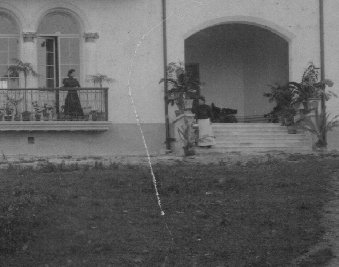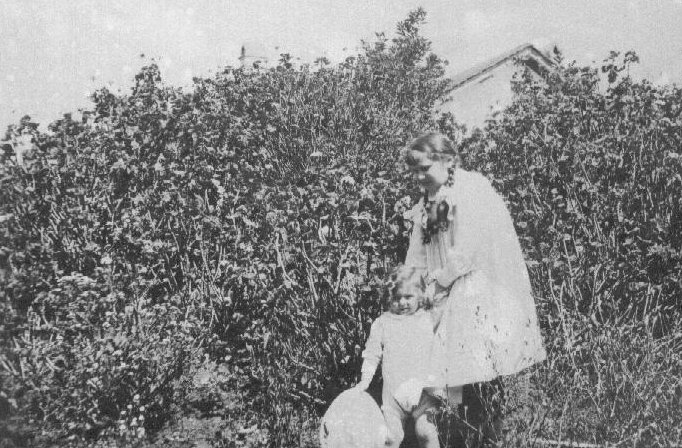Jalapa |
|
| Philippa’s question, "How is it you lived in Jalapa?" set me thinking, and asking myself questions which had never bothered me before. It seemed so natural to pass 6 months of the year in this charming little town that I never thought of how disconnected it was from what others must have thought my real life – set in Yucatán and England. I think I have come up with an answer. When, at the end of 1901, my parents Ernesto de Regil and his wife Katherine Baker came back to Yucatán they had made up their minds to live in a manner quite different from that of my grandparents. I had been born to them late in February in Biarritz. They, I am sure, were loath to take me back to the hot and fever ridden climate of Mérida, even though their new house – the Quinta, built half-way between the northern limits of the city and the nearby village of Itzimna, would be much cooler and be provided with a better water supply than any of the older residences. I feel sure they had discussed this problem and decided on a way of life which would include a yearly visit to the cool and healthy uplands of Mexico. Young men of means from Yucatán, pleased with the cosmopolitan atmosphere of the Capital, were discovering how delightful it was to spend the late spring and early summer months there, and were either buying or building homes in the new suburbs or "colonias" burgeoning along the Paseo de la Reforma. One of the Peóns had built a gloomy and pretentious French inspired mansion at the "________" Circle – Pedro de Regil (Nena’s father) had a miniature "chateau" near the ________ statue – a fantastic edifice of turrets and pepperpots set in a stiff formal garden which, as I remember, included a monkey puzzle tree. In view of the deep friendship between Tio Perico and my father the latter traveled to Mexico City in search of a small house which he and his family could use which would be in the same general neighborhood. His sister Joaquina, wife of Tomas Viamonte, had a house in _________ but my father preferred a more interesting neighborhood. He found such a place just opposite the Cuahtemoc statue, a small red brick town house distinguished only by two great yellow mimosa trees growing in the garden facing on the Paseo. But we were not destined to occupy the house. My father died early in 1903 when he was in Mexico City negotiating the purchase. In 1905 my mother, my governess, Miss Cogan, and I found ourselves along with Jacinta Aznar and Josefa de Regil (who later married Aurelio Portuondo) in a little hotel in the main thoroughfare of Jalapa, capital of the state of Veracruz. We had gone there to visit the Arrigunagas who had recently bought a historical hacienda, El Encerro, at a short distance from the town. This hacienda had belonged to Santa Ana and had figured in Mexican history of the period. It was a charming place with fine orchards and cattle roaming the pastures. The Arrigunaga family was delighted to have a cool place in which to escape the heat of Mérida. In Jalapa itself another very pathetic Yucatecán was seeking refuge, Charo Peón, oldest sister of Joaquin and Ana Peón who had been a leper from young womanhood. The disease had been arrested, but she lived away from her family in the company of an Irish woman who served as nurse and companion and one or two family servants. They occupied a nice house in Jalapa on the main plaza with its superb view of the mountains and of snow-covered Orizaba. The Yucatán ladies I have mentioned visited her and Miss Cogan and I also went to see her. I admit I was terrified, having learned all I knew about the illness from Bible history. Jalapa was not only the state capital but was a delightful town with a salubrious climate, beautiful surroundings and a surprisingly cosmopolitan society. The foreign consuls lived here rather than in Veracruz, which was a terrible place. At least their families were settled here. The consuls could easily journey down to the port during the week to attend to business. I remember well visiting the French consular family living in a secluded coffee and citrus orchard within walking distance of our hotel. There was also a Dutch consul and an English one, who liked Jalapa so much that he was building himself a large house next to the Dutch consulate just outside the town. His wife, however, was determined not to settle in this barbarous nation of Indians and half breeds so she issued an ultimatum. He would have to choose between her and the house! Reluctantly Mr. Leary decided to sell the house – and this is where we came into the story. I remember walking to it with my mother and liking the friendly aspect of the house with its thick white walls, green wooden shutters and balconies and great sweep of red tiled roof. The overhang was generous so that on rainy days we could still leave the windows open and enjoy the pure flower-scented air. Most of all I was delighted to find that Mr. Leary had made the workmen, who were laying the narrow grey lava-stone paths of the little formal garden, leave untouched and altering somewhat the direction of the path, a clump of blackberry and other bushes in which was a tiny nest occupied by a small bird setting on her eggs in a tidy little nest. Only after her brood had grown and were ready to fly away was the thicket cleared. I do not remember when we moved into the Jalapa house. It must have been sometime in 1906. I know that we were in Mérida at least till March for in February Porfirio Diaz paid a state visit to that city and I remember standing on a chair in the corridor of my cousin Nena’s house on the Paseo Montejo and watching him go by – Dona Carmelita at his side – in an elegant landau on his way to the Itzimna railway crossing to take his private train back to Pregreso where he and his wife boarded the gunboat and headed for Veracruz. Nena tells me she remembers none of this – perhaps the incident seemed small compared to the excitement of the recent move to her new home. It was a case of instant love between me and the Jalapa house. I loved the big rooms, the fireplaces, my large nursery-playroom with many shelves and cupboards for books and toys, my mother’s bedroom which I shared and the magnificent view from its balcony. It was very exciting to discover what Mr. Leary had left us in the house. It was mostly functional stuff, quite uncomfortable and sometimes even ugly, but somehow it was pleasant to live with. The dinner service was all white with a lace patterned embossed border – but the dessert service was gloriously late Victorian (already unfashionable) with a lot of blue and gold bordering and rather unbelievable pink flowers (Marilyn Muse, my daughter in law, now owns these). In the attic I discovered a huge doll house, but, sad to say, this had been carried up there by the workmen before the carpenters boxed in the attic stairs making a door so narrow that the house could not be brought down. A smaller but far less desirable house did eventually get to my playroom. My mother bought pleasant Japanese mats to cover the plain, unvarnished pine floors – only the drawing room had oriental rugs – and she also had a glorious ruby red carpet used for the staircase. At Christmas time when the white banisters were hung with thick ropes of pine and cedar the effect was breathtaking. The house was full of plants. Geraniums grew in green window boxes. Palms, maidenhair and every variety of fern stood in the dining room, hall and drawing room. The large tile-floored entrance piazza held dozens of pots and one side was screened by a creeper which I have never seen outside of Mexico, a climbing syringa with big, waxy white blossoms and the sweetest scent imaginable. The garden was – except for the small formal piece bordering the house with violets bordering the paths, and roses, heliotrope, lillies and iris filling the prim beds – one of those deliciously untidy floral jungles which are soul satisfying. The soil was so rich that everything flourished. My mother would throw out handfulls of seeds imported from England and in a few weeks we had a wilderness of California poppies, cornflowers, nas.... |
|
|
|
|
|
|
This is a blown up piece of the photo of the house at the top of the page. Who are the women on the balcony and steps?
|
|
|
|
|
|
|
Beatriz and her brother Paul at Jalapa, 1912 |
|
![]()
You can print this story out as an Adobe Acrobat file by clicking here.
This page was last updated on April 11, 2004.
The page is maintained by Ben Muse who may be reached at benmuse@alaska.com .

